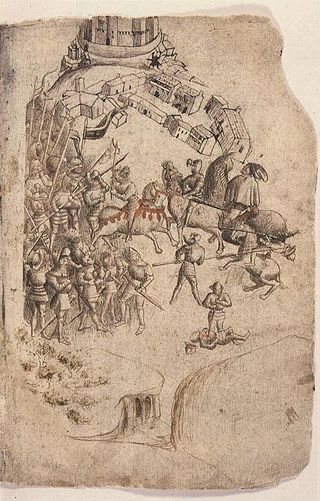
The Battle of Bannockburn was fought on 23–24 June 1314, between the army of Robert the Bruce, King of Scots, and the army of King Edward II of England, during the First War of Scottish Independence. It was a decisive victory for Robert Bruce and formed a major turning point in the war, which ended 14 years later with the restoration of Scottish independence under the Treaty of Edinburgh–Northampton. For this reason, the Battle of Bannockburn is widely considered a landmark moment in Scottish history.
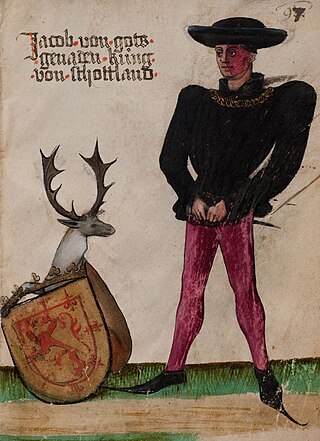
James II was King of Scots from 1437 until his death in 1460. The eldest surviving son of James I of Scotland, he succeeded to the Scottish throne at the age of six, following the assassination of his father. The first Scottish monarch not to be crowned at Scone, James II's coronation took place at Holyrood Abbey in March 1437. After a reign characterised by struggles to maintain control of his kingdom, he was killed by an exploding cannon at Roxburgh Castle in 1460.
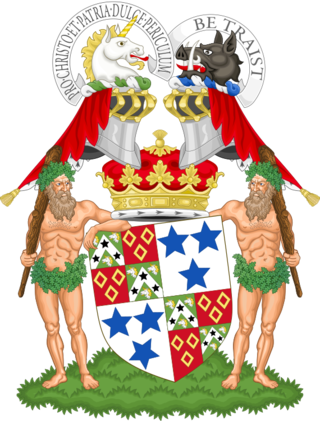
The Duke of Roxburghe is a title in the peerage of Scotland created in 1707 along with the titles Marquess of Bowmont and Cessford, Earl of Kelso and Viscount Broxmouth. John Ker, 5th Earl of Roxburghe became the first holder of these titles. The title is derived from the royal burgh of Roxburgh in the Scottish Borders that in 1460 the Scots captured and destroyed.
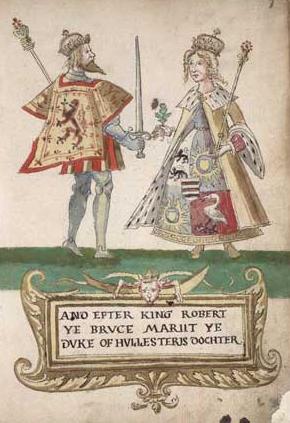
Elizabeth de Burgh was the second wife and the only queen consort of Robert the Bruce. Elizabeth was born sometime around 1289, probably in what is now County Down or County Antrim in Ulster, the northern province in Ireland. She was the daughter of one of the most powerful Norman nobles in the Lordship of Ireland at that time, Richard Óg de Burgh, the 2nd Earl of Ulster, a member of the noble dynasty, the House of Burgh and a close friend and ally to King Edward I of England.
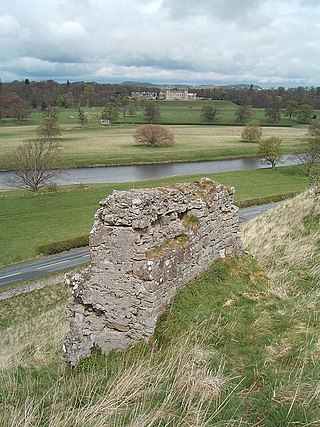
Roxburgh is a civil parish and formerly a royal burgh, in the historic county of Roxburghshire in the Scottish Borders, Scotland. It was an important trading burgh in High Medieval to early modern Scotland. In the Middle Ages it had at least as much importance as Edinburgh, Stirling, Perth, or Berwick-upon-Tweed, for a time acting as de facto capital.

Castles are buildings that combine fortifications and residence, and many were built within the borders of modern Scotland. They arrived in Scotland with the introduction of feudalism in the twelfth century. Initially these were wooden motte-and-bailey constructions, but many were replaced by stone castles with a high curtain wall. During the Wars of Independence, Robert the Bruce pursued a policy of castle slighting. In the Late Middle Ages, new castles were built, some on a grander scale as "livery and maintenance" castles that could support a large garrison. Gunpowder weaponry led to the use of gun ports, platforms to mount guns and walls adapted to resist bombardment.

Kelso Abbey is a ruined Scottish abbey in Kelso, Scotland. It was founded in the 12th century by a community of Tironensian monks first brought to Scotland in the reign of Alexander I. It occupies ground overlooking the confluence of the Tweed and Teviot waters, the site of what was once the Royal Burgh of Roxburgh and the intended southern centre for the developing Scottish kingdom at that time. Kelso thus became the seat of a pre-eminently powerful abbacy in the heart of the Scottish Borders.

Isabella MacDuff, Countess of Buchan, was a significant figure in the Wars of Scottish Independence.

The Anglo-Scottish Wars comprise the various battles which continued to be fought between the Kingdom of England and the Kingdom of Scotland from the time of the Wars of Independence in the early 14th century through to the latter years of the 16th century.
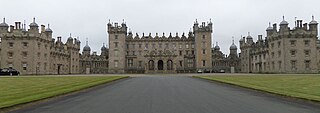
Floors Castle, in Roxburghshire, south-east Scotland, is the seat of the Duke of Roxburghe. Despite its name it is an estate house rather than a fortress. It was built in the 1720s by the architect William Adam for Duke John, possibly incorporating an earlier tower house. In the 19th century it was embellished with turrets and battlements, designed by William Playfair, for The 6th Duke of Roxburghe. Floors has the common 18th-century layout of a main block with two symmetrical service wings. Floors Castle stands by the bank of the River Tweed and overlooks the Cheviot Hills to the south.
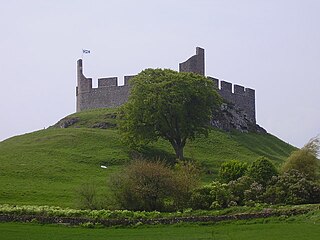
Hume Castle is the heavily modified remnants of a late 12th- or early 13th-century castle of enceinte held by the powerful Hume or Home family, Wardens of the Eastern March who became successively the Lords Home and the Earls of Home. The village of Hume is located between Greenlaw and Kelso, two miles north of the village of Stichill, in Berwickshire, Scotland.. It is a Scheduled Ancient Monument, recorded as such by Historic Environment Scotland.

Halydean is a Scottish feudal Crown Barony and Lordship in Roxburghshire in the neighbourhood of Kelso, in the Borderlands of Scotland, along the River Tweed. This area along the Tweed is home to the Scottish border clans, including the Armstrongs, Douglases, Elliots, Johnstones, Kers, Moffats, and many others. The Barony and Lordship of Halydean (Holydean) is one of the oldest Norman feudal baronies in Scotland with a living claimant.
Events from the 1310s in England.
Mary Bruce was the younger sister of Robert the Bruce, King of Scots. During the First War of Scottish Independence, she was captured by the English and imprisoned in a cage at Roxburgh Castle for about four years. She was the daughter of Robert de Brus, 6th Lord of Annandale, and Marjorie, Countess of Carrick.
The Capture of Roxburgh was a siege that took place in 1314, which was a major conflict in the First War of Scottish Independence. This siege was a prelude to the Battle of Bannockburn.
The capture of Roxburgh was a siege that took place during the Anglo-Scottish Wars. James II of Scotland had started a campaign to recapture Roxburgh and Berwick from the English, while the rulers of England were occupied with the Wars of the Roses. King James would die during the siege being blown up by a cannon.

The Rough Wooing, also known as the Eight Years' War, was part of the Anglo-Scottish Wars of the 16th century. Following its break with the Catholic Church, England attacked Scotland, partly to break the Auld Alliance and prevent Scotland being used as a springboard for future invasion by France, partly to weaken Scotland, and partly to force the Scottish Parliament to confirm the existing marriage alliance between Mary, Queen of Scots, and the English heir apparent Edward, son of King Henry VIII, under the terms of the Treaty of Greenwich of July 1543. An invasion of France was also contemplated.
Sir Ralph Bulmer of Wilton in Yorkshire, was an English knight and soldier active on the Scottish border and during the war of the Rough Wooing.

Cavers Castle, also known as Cavers House, is a ruined tower house located at Cavers, Scottish Borders, Scotland. Cavers Castle was a much extended tower house of the Douglas family dating back to the 15th or 16th century, and built upon the site of an earlier stronghold of the Balliols. It was repeatedly attacked during the 16th century wars with England, and substantially remodelled in the 17th century to form a mansion house, itself extended and remodelled in baronial style by Peddie and McKay in the 1890s. It was eventually deroofed and partially demolished in the 1950s, and was sold most recently in 2019. There are developing plans to restore the building, which is a listed building.















